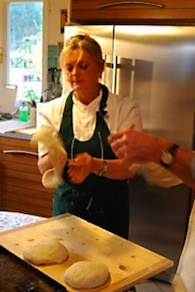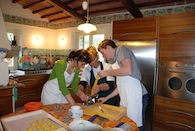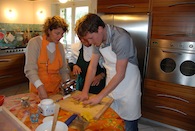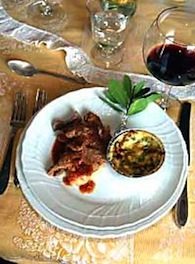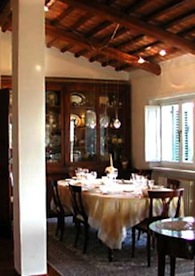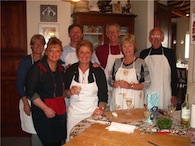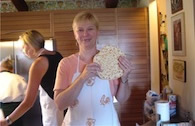A typical cooking class
The following is an account of a typical cooking lesson by our clients Mary and Darci. This will give you an idea of what to expect from our classes.
My daughter and I had been in Perugia for a few days, enjoying one meal after another of the incredibly simple and delicious regional cuisine. We had been wondering about home cooking in the area when we saw an ad for umbriacooks4u. We had to do it and spoke to Nonie on the telephone.
Nonie met us at the meeting point we’d agreed on and drove us up backroads through the rolling hills to Tita’s stone country house, which is a few miles outside of Perugia.
Tita met us at the door, and upon entering her home the first sensation we felt was how warm, elegant and cozy her home is. We were in a home away from home, and it was such a pleasure after almost two weeks in cities and hotels.
We were offered immediately something to drink and were given a tour of the house. Both Tita and Nonie made it clear that while we were there to cook we would also be free to roam around and to feel at home all day.
We started the cooking class discussing the menu and recipes, which Nonie had already prepared for us. That saved us much time in writing and gave us the chance to concentrate more on what was happening.
We were happy to find out that the menu included Umbrian dishes and some recognizably Italian dishes and that we would be learning the two basic culinary techniques that are used together for the making of sauces, stews and soups: Battuto (to beat) and Soffritto (to sauté or fry). As the day passed by we realized that all of the ingredients we were using could be found in our own country (America) and that we were familiar with most of the ingredients, though we never thought of putting them together to make a meal.
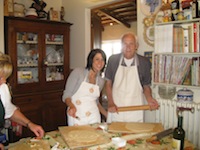 Prior to our arrival, Tita had prepared all the herbs and other seasonings we needed to use, as well as the vegetables, so we just had to do the cutting. We were charmed to learn that most of the herbs and vegetables came from her own garden.
Prior to our arrival, Tita had prepared all the herbs and other seasonings we needed to use, as well as the vegetables, so we just had to do the cutting. We were charmed to learn that most of the herbs and vegetables came from her own garden.
It was a complete hands-on-lesson, not stressful at all. We talked and laughed about our mistakes, and felt comfortable asking silly questions. That day we really got to experience how simple but passionate cooking can be.
We made four antipastos--two required cooking and two were arranged cold. Each had a story and a tradition. For instance, we learned how to cook Torta al Testo, a very special Umbrian handmade flat bread prepared with water, flour, salt and olive oil, on cooked on a special stone, il testo. In the 1800’s most families lacked ovens so various types of flat breads were cooked on roughly polished slab of stone that was kept in the fireplace.
During Nonie’s ongoing explanations of the culinary traditions and history of the Umbrian Kitchen, she told us why in Umbria the most popular bread is unsalted: due to the heavy taxes on salt levied by the Catholic church until it lost its dominions upon unification in 1861.
Nonie also told us about the traditional dishes of some of the more important holidays. Lentils for New Years Eve, Roasted Goose for August 15, Lamb for Easter, Rice and Rum Fritters for St. Joseph’s, Sweetheart Cake for Easter.
We continued our lesson with a delicious soup made of pasta and chick peas. Nonie explained that the Umbrians are great soup eaters and one of their most traditional soups is this simple blend of chick peas (also known as garbanzo beans) simmered in an aromatic broth with bits of pasta and seasoned at the table with olive oil. We were lucky enough to season our soup with the best-tasting oil that had been prepared from the olive trees right in Tita’s backyard.
We then continued with a pasta dish, Pasta alla Carbonara, which is a well-known dish of pasta with an egg sauce and un-smoked bacon. Tita added a little bit of color by adding chopped zucchinis.
While preparing the veal all’alloro (bay leaves) and cherry tomatoes, Tita also taught us how to make a basic white sauce, besciamella, that was mixed with sautéed artichokes baked in the oven.
We finally learned the ingredients for a basic Tiramisù: marscapone, coffee, eggs, sugar and fingerlady cookies and the recipe for special Umbrian Almond biscuits. These hard cookies are traditionally dunked into vin santo (sweet wine) as they are eaten.
While preparing all these dishes, we were constantly going from the table to the stove. Since Tita’s kitchen is very functional and we were having such a wonderful time, we didn’t find that at all tiring.
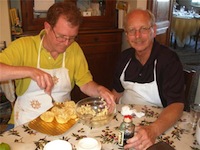 It was an afternoon of learning, chatting, and exchanging experiences and in no time we felt like we had known our two new friends for a long time. Besides learning some new recipes and techniques what most important was that we had the chance to pass the day all’Italiana (in an Italian home.) We loved Nonie’s stories of why she came to Perugia and how she met her husband and her long-time friendship with Tita.
It was an afternoon of learning, chatting, and exchanging experiences and in no time we felt like we had known our two new friends for a long time. Besides learning some new recipes and techniques what most important was that we had the chance to pass the day all’Italiana (in an Italian home.) We loved Nonie’s stories of why she came to Perugia and how she met her husband and her long-time friendship with Tita.
Nonie and Tita were always considerate, asking if we were tired, if we wanted something to drink or eat. The four hours of straight cooking just flew by.
When our cooking lesson was over, Nonie invited us to the lovely dining area with a linen tablecloth and fine china. We ate and we drank many wines --white, red, sweet and grappa -- and finished the meal with espresso. It was an unbelievable feast and an even more unbelievable experience. If we ever return to Perugia, we will definitely go back to our friends Tita and Nonie to learn even more about Italian Cooking.
Mary & Darci
